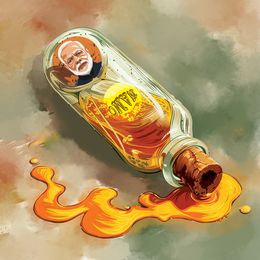In the last mile of 2024 Lok Sabha general elections, two completely divergent narratives have emerged about who is ahead and best placed to form the next government. Though they are not the only individuals on either side of the trenches to have made these arguments, we can, for the purpose of shorthand, call it the Prashant Kishor and Yogendra Yadav schools of thought.
I was the first to interview Kishor. We met in Patna, where the political consultant-turned-politician—his party Jan Suraaj will contest the next assembly elections—set the cat among the proverbial pigeons with his remarks. While there was a lot of focus on his prediction that the BJP will be back, “by the same or slightly more”, intriguingly there has not been as much debate on his description in the same interview, of the prime minister being, in his words, “a brand in decline”. Likening it to “a century with six dropped catches” Kishor has blamed the opposition for “poor fielding”. He forecasts a “weakened prime minister” whose main resistance will come from the general public in what he is sure will be Modi’s third term.
Yadav, a supporter of the INDIA alliance, has an entirely different sense of what happens next. In a conversation with me, he underlined that he was not talking about a ‘1977-style’ mass wave of anger against the incumbent government, but “a return to normal politics” where a phase by phase decline, combined with the dip in turn out numbers, has now painted a likelihood of the “BJP, maybe even the NDA, slipping below the majority mark”.
Is there a space between these two predictive arguments that we know to be true?
I won’t hazard any guess on numbers. But here are some observations from my road trip traversing the distance between Kanniyakumari and Kashmir—covering 12 states and 12,000km over 40 plus days.
Modi remains the dominant political brand across India. There is more incumbency against local MPs of the BJP than against the prime minister. Whatever the eventual outcome, there has been a spirited fight in this election.
The election feels more competitive than anyone would have forecast at the beginning of the campaign. Modi’s own voters want him to dial down religious rhetoric and Hindu-Muslim barbs. The biggest applause for Modi comes on matters of internal security, abrogation of Article 370, infrastructure and India’s stature in the world.
One thing voters want Modi to do differently (apart from toning down religious politics) is to focus more on jobs.
There is no palpable anger, but in many places, there is despondency and disquiet—small street vendors and shopkeepers spoke often of “sannaata hai” (everything is still) when I asked about how their businesses were doing. Yet, they did not suggest that they would vote differently than before. Young men are agitated about jobs. The four year cap on Agniveer, the new military recruitment scheme, is a genuine issue of angst in states like Uttar Pradesh, Rajasthan and Haryana.
There is no single emotive issue that defines the election. The Ram temple, while welcomed by millions of devout Indians, does not come up in political conversation. These are disparate, seemingly unconnected observations in what’s being called ‘a zero wave’ election.
For the rest, we must have the humility to say the following three words—we don’t know—and wait patiently till June 4.
editor@theweek.in


